Tony Robbins taps me gently on the knee.
He has a question for me. He says it’s the most important question I’ll ever answer. He’s sitting on a couch in the library of his oceanfront mansion in Palm Beach, Florida, beneath a life-size painting of an elephant. (“Elephants are symbols of success,” a contract sound engineer working at his house noted earlier in the day. “Elephants and pineapples.”)
Robbins leans his massive 6-foot-7 frame forward. His voice is deep, gravelly, and his dark eyes are fixed and intense.
“Do you want to be happy for the rest of your life?” he asks
Related: 5 Ridiculously Easy Things You Can Do Every Day to Feel Happy
“Sure,” I say without thinking about it too much. There’s something about him, about his charisma and the way his voice fills a room that makes you want to agree with him. But that isn’t good enough. He wants me to think about it.
“I’m asking you,” he says. “Are you committed to being happy, or in a beautiful state? Do you really want that?”
The room is quiet for a moment, and I think about the prospect.
“Well,” I say, “I don’t know if I want to be in a beautiful state all the time, even if I’m at a friend’s funeral.”
“Why not?” he says back to me instantly. “Let’s question that thought.”
To be honest, I’d never wondered why I’m sad at funerals. It’s just always been that way. The grief, the pain of the loss, the pain everybody else is in, it’s an incredibly sad ritual. I’d never even considered the idea of not being sad at a funeral.
“I feel like if I weren’t sad, I wouldn’t be paying the appropriate tribute,” I tell him.
“Why not? Let’s question that thought,” he says again. “Why should you live in pain? Would your friend who died want you to feel that way? Or would your friend want you to be strong so you can support the other people there in a suffering state? See, you’re focused on you.”
A beautiful state can be joy or playfulness or courage or creativity or decisiveness or any other number of things that aren’t suffering.
He is explaining to me that every experience in life can be divided into two categories: Either you’re suffering—stressed, overwhelmed, depressed, angry—or you’re in a beautiful state. He says a beautiful state can mean happiness, but that’s not all. “If you’re happy all the time, your face hurts,” he says. A beautiful state can be joy or playfulness or courage or creativity or decisiveness or any other number of things that aren’t suffering.
Robbins is probably the biggest name in the history of the personal-development field. At 56, he’s been coaching people for nearly four decades, since he worked for Jim Rohn in the late 1970s. He’s advised presidents and business geniuses and some of the greatest athletes in history. He still talks to hundreds of thousands of people every year, in countries all over the world, with attendees paying up to $10,000 per seminar. He’s an incredible salesperson, and although I’m skeptical by nature, he’s selling me now on the idea of walking through life in a beautiful state.
He tells me that when he goes to a funeral, it’s to pay homage to that person. “The best way to pay homage is to bring the best part of their spirit to the people there and remind people that there’s a part of this person we can all take in. And the best way to honor them is to take that in and live that part as part of us.”
Most of our expectations around grief—how we should feel when someone dies and for how long—are cultural constructions, he explains.
“I’ve had the same thoughts as you. Some people stay depressed for a year, because that’s their belief system. It’s nothing but conditioning. It has nothing to do with reality. They believe, I should suffer for a year and then I can be happy. But when you suffer for a year, it’s pretty hard to rewire yourself from that.”
He points out that in other countries, funerals are different. In the Indian city of Varanasi, for example, they are often celebrations, because Hindus believe dying in that city will bring salvation. Robbins has been there several times with his wife, Sage, and they marveled at the joy people felt walking by towering stacks of bodies. He also stresses that helping other people is one of the few things that always feels good, and if you’re suffering, it will be much harder to lift other people, to give.
Related: Tony Robbins on Success Through Giving
“A beautiful state is infectious when it’s real,” Robbins says. “I’m not talking about the manufactured, I’m-happy-no-matter-what type of thing. It’s not just happy. It could be having the courage to say, ‘None of us should sit here and suffer. Death happens to all of us and none of us knows when it’s here, so let’s use this to live more fully.’ ”
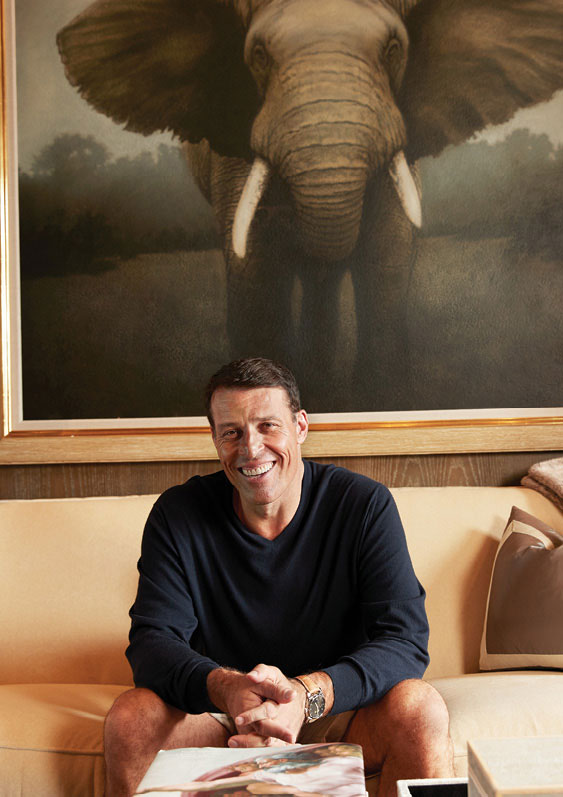
STEWART COHEN
No matter what I ultimately decide, he says the most important thing anyone can do is re-examine all of those fundamentally unquestioned thoughts: Why do I believe certain things? Why do I expect certain things? Why do I behave in certain ways? Why do we get sad at funerals?
“All my suffering, it didn’t come from the past,” he says, his voice softening. “It just came from believing certain thoughts. And now I just question those thoughts.”
Robbins has been trying to live in a beautiful state for about a year and a half, since a friend explained the concept. “If you’d asked me then what my life was like, I’d have said, ‘It’s unbelievable, magnificent, such a blessing. I’ve worked my ass off and I’ve earned it and there’s been grace.’ But I still wanted to take it to another level.”
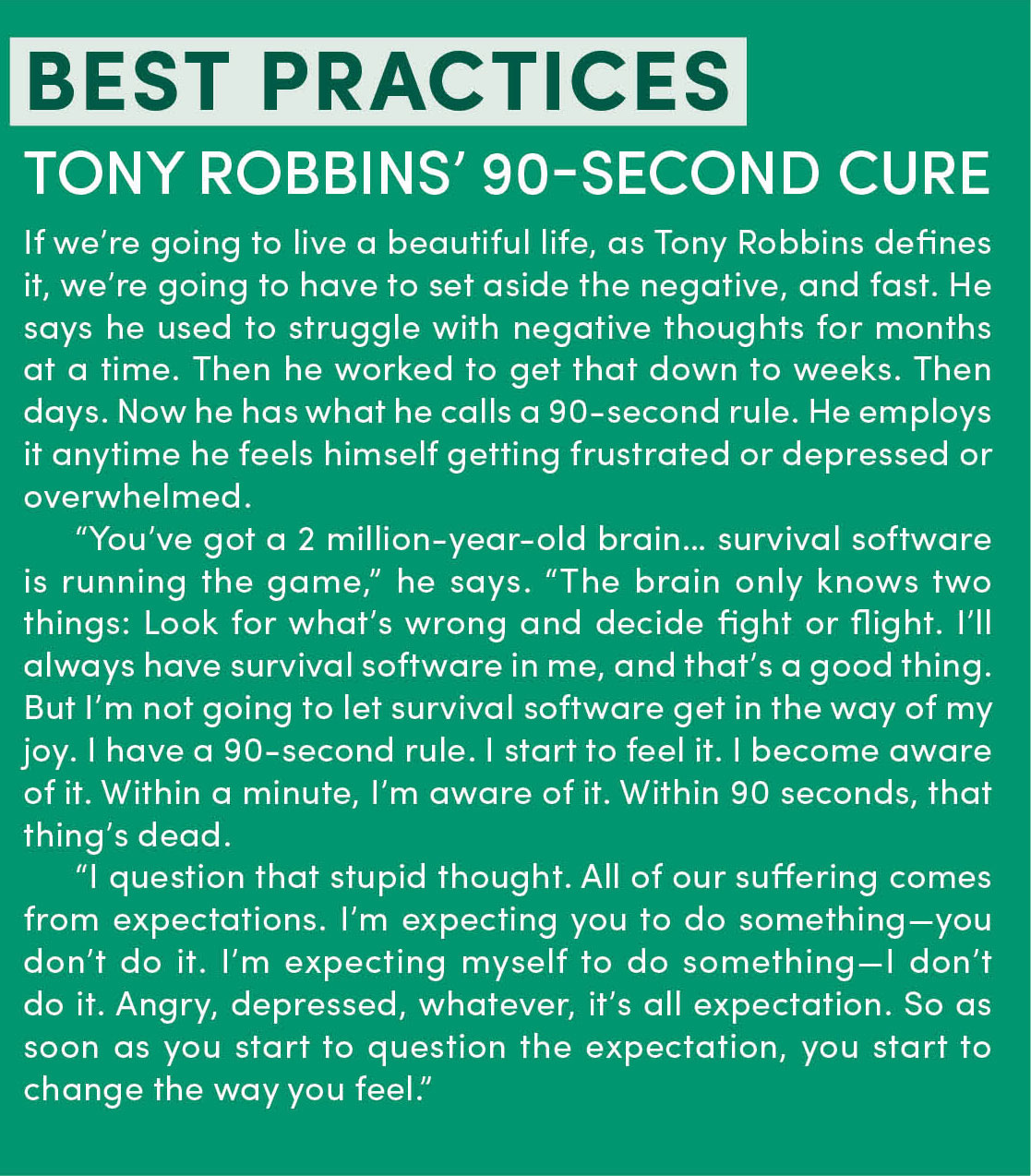
As soon as he made that decision, though, it was put to the test. After a snowboarding injury, he went in for what he thought would be routine rotator cuff surgery and was told his spine was severely compressed and he was at risk of paralysis. Not long after that, he says he started having small memory lapses for the first time in his life, and he was told that years of eating tuna and swordfish had left him with off-the-charts high mercury levels in his body.
“The doctor looked at me,” Robbins says. “He told me: ‘We have no great solutions.’ ”
***
Robbins’ house is a monument to successful living. His pool has an infinity edge facing the beach, and there’s a hot tub and an all-weather putting green a few feet away. He also has a small cold-plunge pool, a 2-foot by 3-foot tank maintained at 57 degrees, in which he completely submerges himself for one minute every morning. (When he’s staying at his house in Sun Valley, Idaho, he takes his daily dip in the snowy river.) Every room inside the mansion, from the foyer to the game room, is well-appointed, with art collected from all over the world. In addition to the elephant painting, there’s an even bigger painting of a horse, hanging over the winding staircase. A new addition on the front of the house will comprise another 12,000 square feet, including indoor basketball and squash courts.
The entire estate is a testament to his durability. Most of the other people who were making infomercials in the 1980s aren’t living like this now. And it’s been a long evolution: from fresh-faced self-help coach in his early 20s to infomercial star to leadership coach to general celebrity—and a memorable guest-starring role in the Jack Black movie Shallow Hal (2001). These days he’s still putting on seminars, but he’s a businessman with diversified interests. Robbins owns a part of more than 30 companies, with more than 1200 employees and $5 billion in annual sales, in fields ranging from sales coaching to Major League Soccer. (He’s a named investor in the new Los Angeles franchise scheduled to begin play in 2017.) He “actively manages” 12 of those companies, which means there’s always another email or phone call or meeting or flight to the other side of the world.
Over the last decade, he’s focused much more on teaching financial lessons. For his 2014 No. 1 New York Times best-seller, Money: Master the Game, he interviewed 50 financial experts—largely self-made billionaires—with the goal of condensing the most important concepts in a way regular people could understand. The resulting 650-page hardcover version sold over a million copies. He donated the $5 million advance he received for the book, and secured partnerships to provide over 100 million meals through Feeding America. After seeing so many people lose their homes and retirement savings in 2008, he says he wanted to find a way to help. Robbins has a follow-up book, about strategies to invest in an unpredictable market, due out Feb. 28. The title: Unshakeable: Your Financial Freedom Playbook … Creating Peace of Mind in a World of Volatility.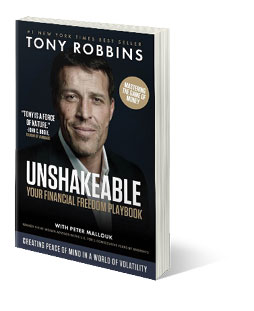
“I’ve experienced visceral changes over the years,” he says. “In the very earliest days, it was ‘Hey, do I know you?’ And then ‘Hey, you’re Tony Robbins.’ And then in the infomercial days: ‘Oh you’re the guy who sells real estate.’ Now it’s ‘I’ve been listening to your stuff for 35 years.’”
A Netflix documentary released in 2016, Tony Robbins: I Am Not Your Guru, has added another new chapter to his life, too. At a UFC fight he went to not long ago, there were young men in their early 20s approaching him all night, all talking about the movie. A live Facebook chat garnered more than 500,000 live viewers on the first night the documentary was available to stream.
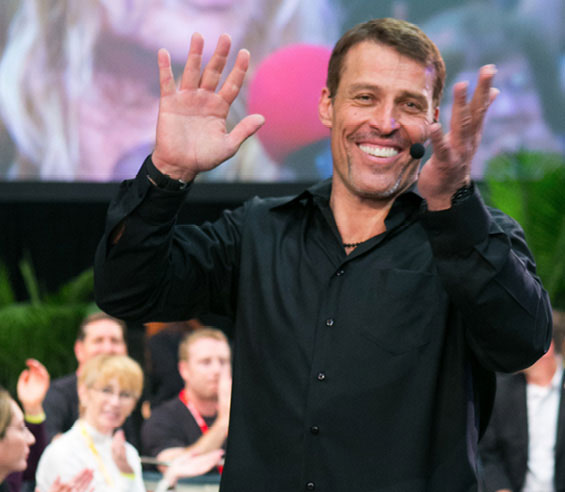
The film is directed by Joe Berlinger, whose career has consisted largely of documentaries about murders and mobsters and Metallica. (Robbins had no editorial say and didn’t profit.) It follows Robbins and an audience of thousands through an intense six-day seminar in Boca Raton, Florida. Watching it, you get a sense of Robbins’ approach to coaching. There are flashing lights and loud music, and the massive crowd is encouraged to dance and sing. You see Robbins working himself up and spinning in place before he comes onstage, and then you see him singing, too. The entire thing feels like a high-energy church revival.
You also get to see the way Robbins works with individuals: talking to people in front of the entire group about suicide, about how their deepest problems manifest in daily frustrations, about bad relationships with spouses and parents and children and co-workers. The interventions are condensed for time, but the drama is both engaging and cringe-worthy. There are tears and a variety of breakthroughs throughout.
Related: The Pursuit: Tony Robbins’ 5 Steps to Break Through Your Limits
Robbins says he’s been inundated with messages from people who’ve been touched by the movie, including one from the filmmaker Michael Moore. “He told me it changed his life,” Robbins says. “Michael Moore is not a big personal-development guy. He thinks it’s all [B.S.]. But he said, ‘This made me a better person. This made me a better filmmaker. This movie will change lives.’ ”
Robbins says Moore “apologized for being so judgmental.”
***
Don’t call Robbins a “motivational speaker.” He hates it.
Don’t call Robbins a “motivational speaker.” He hates it. He’ll tell you that by the time someone gets to him, by the time someone has paid for his seminar or book, that person is already hungry.

STEWART COHEN
“People get hungry for different reasons,” he says. “But that’s the common denominator. I’m not here to motivate anyone. That’s such [B.S.]. I’ve never done that. But I do believe in energy. If your energy is low, nothing’s gonna happen. So I create an environment that’s like a rock concert. Only instead of 2½ hours, it’s 50 hours or 72 hours.”
He says that energy is part of his goal of effecting real, lasting change in people. If you have more energy and emotion, you’re more likely to remember any breakthroughs and introspective experiences. He says emotion is the reason you can probably remember where you were on Sept. 11, 2001, but you probably can’t remember where you were on Aug. 11 of the same year.
“Information without emotion is barely retained,” he says.
The energy is also part of the entertainment factor. It’s vital for Robbins to entertain. “People don’t want information,” he says. “They don’t want education. They want entertainment. So you’ve got to entertain them first. If I can make you laugh, cry, move in ways you never thought possible, and time disappears, then I’ve earned the right to educate you.”
“I don’t teach people just to solve their problems. I help them solve what caused the problem in the first place.”
He sees himself as a strategist, a sort of all-purpose consultant for all aspects of life. “I don’t teach people just to solve their problems,” he clarifies. “I help them solve what caused the problem in the first place, which is their beliefs and values and goals.”
This is why he also doesn’t like the term guru. The title of the Netflix documentary is taken from something Robbins says often. He says the word conjures a cultlike figure, telling people what to believe and what to do.
“I’m the exact opposite,” he says. “If you watch what I do, it’s ‘What do you believe? What do you value? What’s most important to you compared to how you’re living, and let’s shift that so that you’re living consistent with what matters to you.’ My life is not your model. You’ve got to figure out what matters most to you. I’m here to help people have a more extraordinary life. I think most people already have one; they’re just not appreciating it fully.”
Related: 126 Ways to Be Extraordinary
Still, he often gives examples from his own struggles in life: the fact that his mother hit him and poured soap down his throat, the time his father was so stubborn that he argued with the charitable man giving the family a free Thanksgiving dinner on a day they otherwise wouldn’t have eaten, the fact that he developed a possibly fatal tumor on his pituitary gland—which is why he’s so large, a man our ancestors would have called a giant.
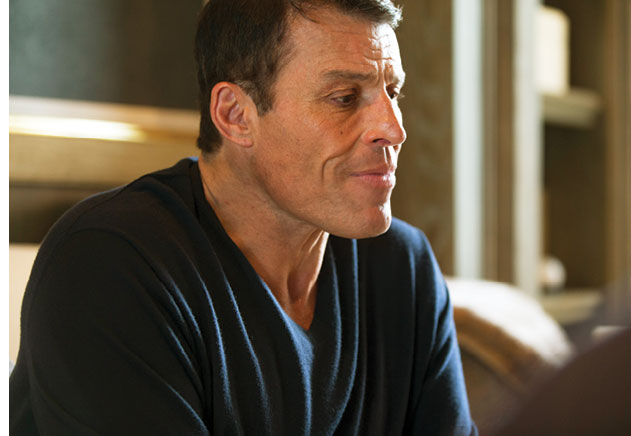
STEWART COHEN
As he talks, he makes goals and dreams seem possible, or at least he makes the idea of working toward them seem more worthwhile. I spent five hours with him in his house, talking about everything from psychology to writing habits to what kind of protein bars he eats (a Canadian brand I’d never heard of before). He’s had a lot of ups and downs in life, but he strikes me as someone who earnestly wants to help people, to ease some of the suffering in the world. Maintaining a focus on philanthropy, Robbins is active in multiple charities, most notably providing a grand total of 250 million meals through a partnership with Feeding America (they’re on target to feed a billion people over the next eight years). There’s something about his confidence that makes you believe you can be a better person.
I left his house trying hard to maintain a beautiful state the way he described it to me. In the next few days, I had both long airport delays and a hellacious stomach bug. I tried to remember the idea of a beautiful state. When I was feeling bothered by something, I challenged my own expectations.
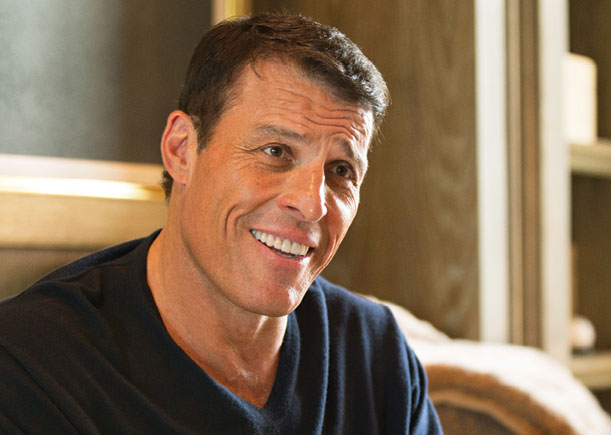
STEWART COHEN
The delayed flight was annoying at first, but then I thought about what an incredible achievement air transportation truly is, how fortunate I am to get to fly so inexpensively, and how only a few generations back this journey would have taken weeks. And although I’d land a few hours later than originally expected, I got to watch a pretty impressive storm from the large airport windows and have a drink with some equally stranded strangers.
While my stomach bug was physically unpleasant and quite disruptive to my plans, it didn’t take long before I was looking for things to appreciate. I started thinking about how wonderful my wife is for taking care of me while I was feeling so bad, and how much knowledge I gained after I was inspired to spend a day reading and learning about norovirus.
***
Robbins says there’s nothing that he really fears. He has a list of things he’d really like not to happen—like loved ones dying, for instance—but he says that being emotionally and mentally fit means being ready to deal with hard times, too.
“It’s not that you’re happy only when things go your way,” he says. “You’re happy when it rains on your parade. You’re happy when it [defecates] on your parade. You’re happy when people betray you. Not happy—beautiful state. Because you found out that they screwed you, and now they’re out of your life. It might be painful, but you can deal with it. It’s not going to drag out another 10 years.” He adds: “That isn’t positive thinking. That’s intelligence.”
As we’re discussing Robbins’ idea of the beautiful state, Sage walks into the room. A former acupuncturist and phlebotomist, they met at one of his seminars and married in 2001. She came in to remind him that he has a photo shoot to get to, but soon she’s sitting next to him on the couch, sharing her experiences living in a beautiful state.
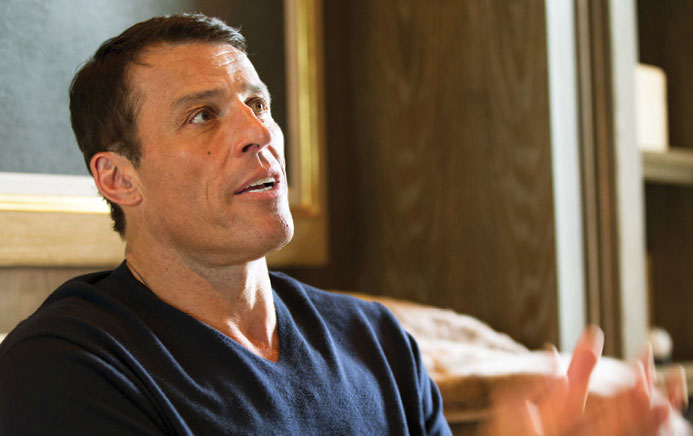
STEWART COHEN
“It was such a perceptual shift that affected my inner reality, which therefore affected my life on a massive scale,” she says. “I wasn’t aware of what I wasn’t aware of. I thought my problems were all outside of me. I thought it was everything else. It’s easier to look at your husband: He’s never this, he’s never that. You look at your mother: She’s always complaining, she’s always telling me what to do.”
Sage says she often describes it as “caring less and loving more.” She talks about her grandmother’s funeral, and how the room was filled with the laughter of people remembering good times and stories from the past. “It was really a beautiful thing,” she says.
One of the things she used to worry about most was her husband’s health. She’d see him come offstage after 60 or 70 hours of talking and moving around and leading emotional interventions, and it was like he’d run an ultramarathon. She’d beg him to stop—something Robbins says he never wants to do.
“I eventually eliminated the expectation that he’d do that,” she says. “Now I’m just present, loving him.”

STEWART COHEN
They both agree the philosophical shift prepared them for his most recent health issues, what he refers to euphemistically as “this [stuff] with my body.” Not only was his back collapsing, but he had so much mercury in him that he says the police came out to interview his wife and staff to make sure nobody was intentionally poisoning him.
He’d always prided himself on his memory, but now he’d find himself in the middle of a long story and wonder why he began telling it. And the mercury was causing a type of anxiety that made him want to run no matter where he was or what he was doing, something he’d never dealt with before.
“In the beginning, there was suffering,” he says. “I had to get my [stuff] together, honestly on the verge of tears. But I was like, Could I die?”
He started a series of detox therapies, including hyperbaric chambers, chelation and colonics. Six, seven hours a day dedicated to this. He says he quickly began to see it as a gift, though. Like the universe gave him the opportunity to practice a beautiful state, even under difficult conditions. He compares it to a weightlifter upping a bench press by a few hundred pounds.
“I’ve lived in a beautiful state, in those little oxygen tubes they put you in, it feels like a freaking coffin,” he says. “You’re stuck there for two hours, and if you have to pee it takes eight minutes to get out.”
Maybe he should be scared or worried, but he questions those thoughts. He tells me he’s feeling better these days, he’s still detoxing. It hasn’t kept him off the stage, he says, and he hasn’t canceled any events. And now when he talks to people, he reminds them to get their metals checked—and to eat less fish. He smiles, living in a beautiful state.
“It’s another way I can help people that I never knew about before.”
Related: Rohn: How to Live a Beautiful Life
This article originally appeared in the January 2017 issue of SUCCESS magazine.









